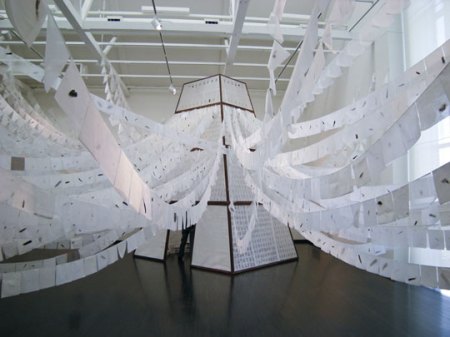
Navigation series installation by Lena McGrath Welker photo by Ryen Welker
Lena McGrath Welker has spent the last six years creating the final works of the Navigation series, which currently fill the galleries of the North Dakota Museum of Art and which will remain on exhibit through January 9, 2011. The Navigation series addresses ways of thinking about the accumulation and transmission of knowledge and wisdom. What gives written language its power? In what ways does language fail us, and in what ways does it allow communication to take place?

Lena-Welker.Navigation-Cycle photo by Ryen Welker
In 2004, Welker showed four bodies of work from the series at the NDMOA. At that time, Museum Director Laurel Reuter invited the artist to return with the final installation in this, her major lifework. Twelve years in the making, the Navigation series concludes with the current installation, [chime]. The press release prepared by the Museum, describes Welker’s process in considerable detail and is excerpted below.
![Lena-McGrath-Welker---Navigation-[chime]Image-by-Ryen-Welker](https://arttextstyle.files.wordpress.com/2010/12/lena-mcgrath-welker-navigation-chimeimage-by-ryen-welker.jpg?w=450)
Lena Mcgrath Welker Navigation Chimeimage installation by Ryen Welker
Moving through her studio during the last six years have been hundreds of pounds of alabaster waiting to be carved, recently cast porcelain scrolls, weavings perpetually rolling off two looms, fabric collages, huge pastel and silver leaf paintings, stacks of glass, and on and on. Since returning home in 2004, Welker has learned to carve alabaster, to add the making of soft-ground etchings to her repertoire of printmaking skills, and to master historical bookbinding techniques including traditional Coptic, longstitch, tackets, accordion methods. And always, her work is interwoven with drawing.The pace of her work, however, has been determined by her health. Since that first North Dakota show, Lena was diagnosed with a non-malignant brain tumor. In December of 2006, she was treated with a relatively new gamma-knife radiation procedure intended to buy time for the artist— five, ten, or even fifteen years. Yet there are days she cannot work, bound to her bed with fierce headaches.
![Lena McGrath Welker - Navigation [chime] Image by Ryen Welker](https://arttextstyle.files.wordpress.com/2010/12/lena-mcgrath-welker-navigation-chime.jpg?w=450)
Lena McGrath Welker photo by Ryen Welker
Even while living with a brain tumor, she has continued to develop her craft skills. In the alcove of the upstairs gallery, the viewer will find [chart] with small stacks of incised glass tablets. They are accompanied by vitrines filled with hand-dyed, indigo folios embellished with drawings and stitched imagery of what appear to be arcane maps. Floating above them are huge drawings incorporating Ptolemy’s diagrams, star measurements, constellations, abstract counting marks, the geometry of navigation systems, signs and symbols from Greek mathematical texts and scanned images of deep-sky nebulae.The sixteen-foot high, steel skeleton for a dovecote anchors
[flight] in the west gallery of the main floor, the inside of which is skinned with translucent paper. The dovecote is home to funerary urns, blackened bronze and copper begging bowls resting on a low slate wall, and 120 often-blank, bound books stacked on the floor. Accompanying the dovecote are some 3,000, nine-inch fabric squares, each having either a single feather attached, or stitching that conveys a sense of writing or counting. They hang from the ceiling beams on fine thread, like Tibetan prayer flags. The feathers represent ideas as the Greeks first conceived them. Repetition abounds throughout the exhibition echoing the repetition of the mantra in meditation, of reoccurring themes in a musical composition, of sewing and weaving and chanting, of waves rolling across a vast ocean.
In the east gallery and hovering just above the floor is an empty organdy room made from bolts of cotton fabric donated by the Pennsylvania company Testfabrics. This centerpiece of the installation [stillness] is surrounded by eight, fifteen-foot, vertical, paper scrolls drawn with dry pigment and graphite. Beneath them are rows of alabaster cairns and small porcelain scrolls. Thirty prints embedded in handmade abaca paper comprise [affinis], hanging on steel frames in the space between the east and west galleries. Their images connect [flight] in the west to [stillness] in the east.Welker named the exhibition Navigation [chime] because “chime has poetic and musical derivation, but it also refers to a system in which all the parts are in harmony, showing a correspondence of proportion or relation.” The artist imagines her wordless books as “a continuation of ancient books still with us, so carefully and beautifully bound, with folios of handmade paper, their words so arcane and unintelligible to us now as to disappear from the page.”
![Lena McGrath Welker - Navigation [chime] Image by Ryen Welker](https://arttextstyle.files.wordpress.com/2010/12/lena-mcgrath-welker.jpg?w=450)
- Lena McGrath Welker – Navigation [chime]
In the exhibition, Welker deals with uncertainty in an abstract and liminal way. She invites people to move through silence. She suggests the accumulation of experience through the physical massing of repetitive objects and motifs, and, finally, emptying out, as colors fade into transparency and words disappear. The transitions from gallery to gallery are equally subtle and connected. Because she uses mostly translucent materials, people are able to experience the work privately, while being aware of the community of others.
![Lena-McGrath-Welker---Navigation-[chime]Image-by-Ryen-Welker.2](https://arttextstyle.files.wordpress.com/2010/12/lena-mcgrath-welker-navigation-chimeimage-by-ryen-welker-2.jpg?w=450)
- Lena McGrath Welker Navigation [chime]
According to the artist, “Many of the materials are light enough to move with the ambient air currents, and with people walking by. People respond to this movement with a ‘bodily’ intelligence, instinctively becoming quiet and walking more slowly. As sunlight pours through the windows and warms the rooms, the scents of silk and indigo are released.”
The North Dakota Museum of Art is located at 261 Centennial Drive on the University of North Dakota campus in Grand Forks. For more info, contact: 701-777-4195 or http://www.ndmoa.com/Current Exhibition/currentexhibition.html. The Museum hours are weekdays from 9 am to 5 pm and weekends from 1 am to 5 pm.
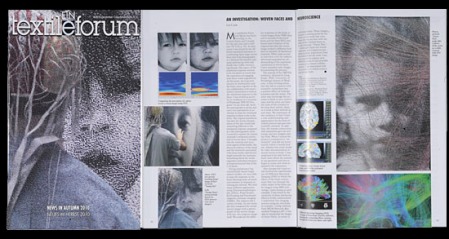
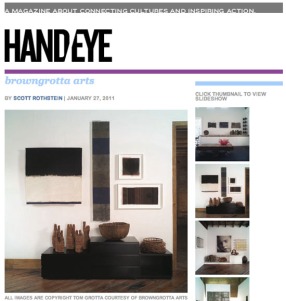 The January issue of the always striking online magazine Hand/Eye included a piece on our singular business/life model, “Living with Art,” by artist and writer Scott Rothstein http://handeyemagazine.com/content/browngrotta-arts. The related slideshow features dozen of art works on display in our barn/gallery/home. (You can read more by Scott Rothstein on his blog, http://artfoundout.blogspot.com, in American Craft magazine and elsewhere.) Meanwhile, the January/February of the UK Crafts magazine includes images from Lizzie Farey’s solo exhibition at City Art Centre, Edinburgh, Scotland http://www.craftscouncil.org.uk/crafts-magazine/latest-issue.
The January issue of the always striking online magazine Hand/Eye included a piece on our singular business/life model, “Living with Art,” by artist and writer Scott Rothstein http://handeyemagazine.com/content/browngrotta-arts. The related slideshow features dozen of art works on display in our barn/gallery/home. (You can read more by Scott Rothstein on his blog, http://artfoundout.blogspot.com, in American Craft magazine and elsewhere.) Meanwhile, the January/February of the UK Crafts magazine includes images from Lizzie Farey’s solo exhibition at City Art Centre, Edinburgh, Scotland http://www.craftscouncil.org.uk/crafts-magazine/latest-issue.  The January issue of Artist Magazine from Taiwan has a several-page article about Norie Hatakeyama by Ming-Whe Liou, with photos by Tom Grotta. We can’t tell you what it says — but it looks good. http://www.artist-magazine.com/magazine/index.php.
The January issue of Artist Magazine from Taiwan has a several-page article about Norie Hatakeyama by Ming-Whe Liou, with photos by Tom Grotta. We can’t tell you what it says — but it looks good. http://www.artist-magazine.com/magazine/index.php. Last, but certainly not least,
Last, but certainly not least,

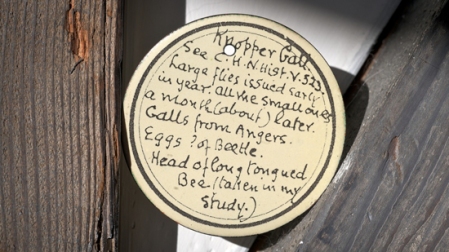




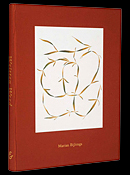
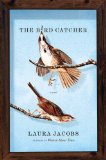

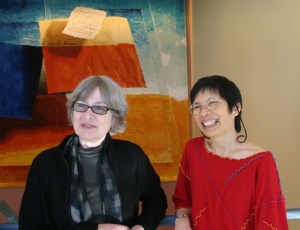

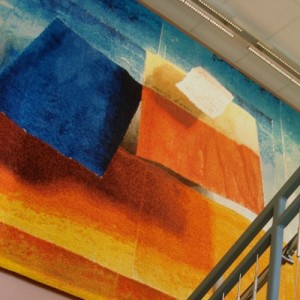
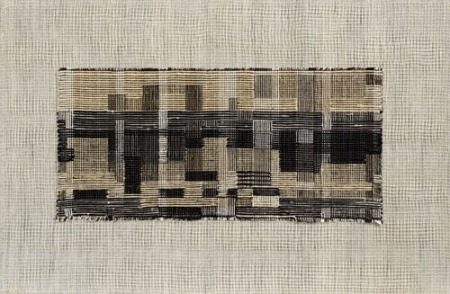

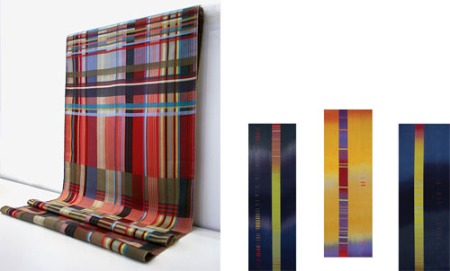
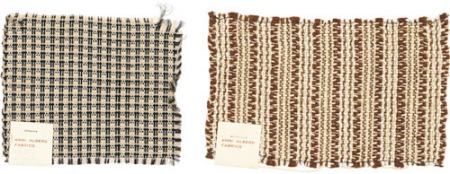

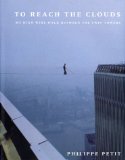
 Randy Walker, who works regularly with threads and ropes and cables, writes, “Although it is a story involving only a single length of fiber,
Randy Walker, who works regularly with threads and ropes and cables, writes, “Although it is a story involving only a single length of fiber, 

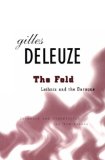


![Lena-McGrath-Welker---Navigation-[chime]Image-by-Ryen-Welker](https://arttextstyle.files.wordpress.com/2010/12/lena-mcgrath-welker-navigation-chimeimage-by-ryen-welker.jpg?w=450)
![Lena McGrath Welker - Navigation [chime] Image by Ryen Welker](https://arttextstyle.files.wordpress.com/2010/12/lena-mcgrath-welker-navigation-chime.jpg?w=450)
![Lena McGrath Welker - Navigation [chime] Image by Ryen Welker](https://arttextstyle.files.wordpress.com/2010/12/lena-mcgrath-welker.jpg?w=450)
![Lena-McGrath-Welker---Navigation-[chime]Image-by-Ryen-Welker.2](https://arttextstyle.files.wordpress.com/2010/12/lena-mcgrath-welker-navigation-chimeimage-by-ryen-welker-2.jpg?w=450)
